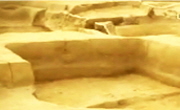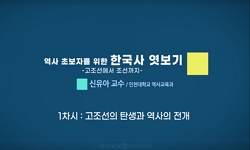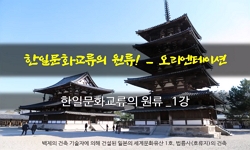백제의 고도인 충남 공주시에 위치한 국립공주박물관 뜰에는 인근 공주시 금학동 절터에서 옮겨 온 대형 석조 광배가 있다. 이 광배의 제작 시기는 일제강점기 때 일본인 학자가 백제 때 만...
http://chineseinput.net/에서 pinyin(병음)방식으로 중국어를 변환할 수 있습니다.
변환된 중국어를 복사하여 사용하시면 됩니다.
- 中文 을 입력하시려면 zhongwen을 입력하시고 space를누르시면됩니다.
- 北京 을 입력하시려면 beijing을 입력하시고 space를 누르시면 됩니다.
공주 금학동 절터 출토 석조 광배에 관한 연구 = A Study on stone Halo(Gaengbae光背) which has moved from Gongju Gemhakdong temple site
한글로보기https://www.riss.kr/link?id=A107024055
-
저자
조원교 (국립전주박물관)
- 발행기관
- 학술지명
- 권호사항
-
발행연도
2011
-
작성언어
Korean
-
주제어
국립공주박물관 ; 금학동 절터 ; 백제 ; 석조 광배 ; 통일신라 ; National Museum of Gongju ; Gemhakdong temple site ; Baekje ; stone Halo ; Unified Silla
-
KDC
900
-
자료형태
학술저널
-
수록면
723-749(27쪽)
- 제공처
- 소장기관
- ※ 대학의 dCollection(지식정보 디지털 유통체계)을 통하여 작성된 목록정보입니다.
-
0
상세조회 -
0
다운로드
부가정보
국문 초록 (Abstract)
백제의 고도인 충남 공주시에 위치한 국립공주박물관 뜰에는 인근 공주시 금학동 절터에서 옮겨 온 대형 석조 광배가 있다. 이 광배의 제작 시기는 일제강점기 때 일본인 학자가 백제 때 만든 것이라는 견해를 짧은 논문 안에 발표하였다. 이 연대는 외형이 연화형 전신광배에 연화문, 화염문이 강조된 점 그리고 공주의 역사 등을 감안한 것이다. 이 판단은 이후 비판 없이 그대로 수용되었다. 그리고 다른 연구도 없는 상황이다. 필자는 석사학위 논문 이래 문양과 도상에 대하여 줄곧 관심을 가지며 몇 편의 논문과 글을 발표하였다. 그 과정에서 금학동 광배의 양식과 문양, 계보와 유형을 파악하게 되었다. 금학동 광배의 양식과 문양을 분석하면 삼국시대와 통일신라시대(668-936년) 요소가 잘 어우러져 있음을 알 수 있다. 특히 주목되는 점은 외형이 삼국시대 양식이고 내부 구분 및 문양들이 통일신라시대 양식에 가깝다는 점이다. 그러나 이 광배의 삼국시대 양식인 외형과 연화문은 이 광배의 제작 시기를 올려 볼 정도로 두드러진 모습이고 큰 비중을 차지하고 있다. 우리나라 통일신라 이후 광배 가운데 금학동 광배와 외형과 내부 구분이 서로 비슷한 광배는 총 8점이 있다. 이들은 공교롭게도 모두 옛 백제 강역인 전라도와 충청도에 위치하고 있다. 결과 금학동 광배의 삼국시대 요소는 백제 때부터 전승된 양식임을 알 수 있다. 그러나 금학동 광배와 같은 백제 양식을 담은 통일신라시대 광배는 이처럼 몇 예에 그침에서 보듯 당시에도 그다지 널리 유포되지는 않았을 것으로 본다. 이 연구를 진행하는 과정에서 금학동 광배의 본존도 찾았다. 그 본존은 금학동 광배 바로 옆에 있다가 국립공주박물관 뜰에 함께 전시된 금학동 출토 불상이다. 이는 길쭉한 비례를 지닌 금학동 광배의 본존이 입상일 것이라는 판단, 머리가 금학동 광배의 두광에 머무르는 점, 광배와 불상의 원래 위치·석질과 그 퇴색 상태 등을 종합하여 내린 결론이다. 이 본존으로 추정되는 불상에도 금학동 광배처럼 삼국시대와 통일신라시대 요소가 어우러져 있다. 금학동 광배는 이와 외형과 내부 구분이 유사한 9세기 통일신라시대 석조 광배보다도 삼국시대 요소를 보다 잘 간직하고 있다는 점 그리고 본존으로 추정되는 불상 역시 삼국시대 요소가 많이 반영된 통일신라시대 불상이라는 점 등을 종합할 때 약 700년경에 만들었다고 본다.
다국어 초록 (Multilingual Abstract)
In the middle of the garden in National Museum of Gongju(國立公州博物館) which is located in at an altitude of Baekje(百濟), Chungnam(忠南) Gongju(公州) there is a large stone Halo(Gwangbae 光背) which has moved from Gemhakdong(金鶴...
In the middle of the garden in National Museum of Gongju(國立公州博物館) which is located in at an altitude of Baekje(百濟), Chungnam(忠南) Gongju(公州) there is a large stone Halo(Gwangbae 光背) which has moved from Gemhakdong(金鶴洞) temple site, located near from Gongju. The time when Halo(which name is derived from Geumhakdong Halo) has been made is known to be during Baekje era, according to Japanese scholar's short treatise during colonial rule times. This 'date' of a Halo is set according to outer appearance of Halo which emphasizes flame like look (hwayeommun 火焰文·光焰文) on the outer of lotus shaped all-around Halo as well as considering the history of Gongju which was capital of Baekjae era. After all, this decision was accepted without criticism. And other studies have been done so far. Since having a continuous interest on patterns and iconography(圖像), I have been working on several research and papers including master's thesis. In the process of research, I was able to identify forms, patterns, genealody and type of Geumhakdong Halo. By analyzing forms and patters of Geumhakdong Halo, you can find well blended elements of Samgook period(三國時代) and Unified Silla period(統一新羅時代, 668-936). Especially, it shows that outer pattern akin to Samgook period like look while interior forms more like that of Unified Silla period look. However, the outer appearance of Halo from Samgook period emphasizes lotus pattern which is prominent enough to take up a large proportion, considering production period of it. Especially, it shows that outer pattern akin to Samgook period like look while interior forms more like that of Unified Silla period look. However, the outer appearance of Halo from Samgook period emphasizes lotus pattern which is prominent enough to take up a large proportion, considering production period of it. Interestingly, all of them are located in Jeolla(全羅道) and Chungcheong(忠淸道) area which were territory of former Baekjae. This results in showing that Samgook period facts of Geumhakdong Halo are derived from Baekjae era. Since the middle of the Unified Silla, there are total of 8 similar Halo that shows similar appearance and internal separation to each other. However, it shows that Geumhakdong Halo which resembles the form derived from Baekjae era is not very widely spread even at the time being. During the course of the study's I were able to find principal(front) image of Geumhakdong Halo as well. The origin can be found from standing Buddha made of stone which is displayed right next to Geumhakdong Halo in garden of Gongju National Museum. This decision is made and done considering judgment that derives from facts which bases in that elongated proportions of the deity with two standing geumhakdong Halo must be standing type, head staying only at the head point (dugwang 頭光) of Geumhakdong Halo as well as considering the condition of original location of the statue, condition of stone and their fading status. Even a Buddah statue which is estimated to be origin of the Geumhakdong Halo shows similar appearance; mixture of Samgook period and Unified Silla era. In a conclusion Gemhakdong Halo is estimated to be made around 700th year during Unified Silla era considering the facts that it shows same appearance and internal separation of stones of Samgook period, more similar than that of 9th century Unified Silla period as well as the Buddah statue which is considered as the origin also reflects Samgook period although it's made during unified Silla era.
목차 (Table of Contents)
- Ⅰ. 머리말
- Ⅱ. 광배의 정의·형태·문양·용어
- Ⅲ. 금학동 광배의 형태·문양 해석
- Ⅳ. 금학동 광배의 제작 연대
- Ⅴ. 금학동 광배와 같은 외형과 내부 구분을 한 광배들
- Ⅰ. 머리말
- Ⅱ. 광배의 정의·형태·문양·용어
- Ⅲ. 금학동 광배의 형태·문양 해석
- Ⅳ. 금학동 광배의 제작 연대
- Ⅴ. 금학동 광배와 같은 외형과 내부 구분을 한 광배들
- Ⅵ. 금학동 광배에 보이는 삼국시대 양식의 유래
- Ⅶ. 금학동 광배의 본존
- Ⅷ. 기타 금학동 광배의 특징
- Ⅸ. 결론
동일학술지(권/호) 다른 논문
-
- 한국고고미술연구소
- 이일갑
- 2011
-
- 한국고고미술연구소
- 이원복
- 2011
-
- 한국고고미술연구소
- 윤용희
- 2011
-
- 한국고고미술연구소
- 전인지
- 2011




 RISS
RISS







